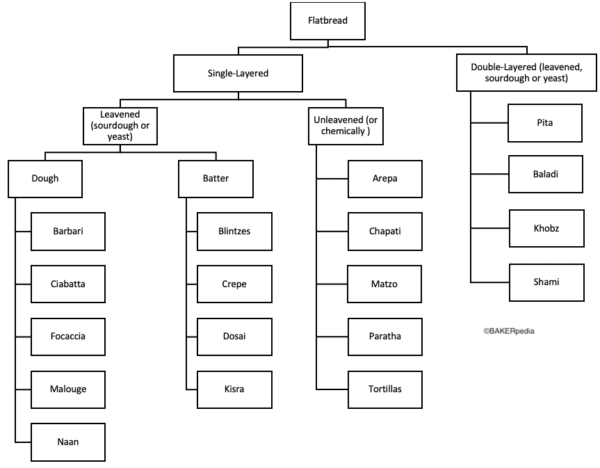Categories of flatbreads2

Origin
Flatbread is considered an ancient food dating back to 6000 years ago. It is a staple bakery product in the Middle East, North Africa, India, Central America, China and Europe. Today, flatbread is consumed on a daily basis by over 1.5 billion people worldwide.1,3
Typical formulation2
| Ingredients | Pita Bread | Chapati | Naan |
| Flour | 63.75% | 62.50% | 61.69% |
| Water | 35.06% | 37.50% | 21.59% |
| Salt | 0.71% | Optional | 0.68% |
| Yeast | 0.48% | – | 0.62% |
| Yogurt | – | – | 15.42% |
Nutrition
Typical nutritional values of flatbreads (g/per 100 g bread):4,5,6
| Component | Pita Bread | Chapati | Naan |
| Water | 29.83 | 33.00 | 29.24 |
| Protein | 10.71 | 11.25 | 11.09 |
| Fat | 2.32 | 7.45 | 7.28 |
| Carbohydrate | 57.14 | 46.36 | 52.39 |
| Ash | – | 1.94 | – |
Commercial production7
General flatbread commercial production process for flatbreads involves:
- Selection of ingredients: wheat flour, water, salt, yeast or baking powder (depending on the type). Other ingredients such as butter or milk can be added to enhance aroma and taste.
- Mixing: uniform mixing and kneading to form a dough.
- Resting: dough is left to rest about 30-60 min to allow gluten development.
- Fermentation: various time-temperature combinations can be used. Dough may be left to proof for 1-3 h at temperatures from 20-35 °C (68-95°F).
- Sheeting: balls of dough are formed and flattened or sheeted into a circular form.
- Baking: flatbreads can be baked at various temperatures (350-550°C / 662-1022°F) and times.
- Cooling: the baked flatbreads are allowed to cool down.
- Packaging: flatbreads can be packaged in common bags, vacuum sealed or frozen depending on the end-use.
Application1,2
Baking requirements for various flat bread recipes can be found in the following table:
| Conditions | Pita Bread | Chapati | Naan |
| Leavening Agent | Yeast | Chemical | Yeast |
| Proofing Time | 20 min | Short Time | 5 min |
| Temperature | 350-550 °C (662-1022°F) | 220 °C (428°F) | 315 °C (599°F) |
| Cooking Time | <20 s | 45 s on one side and 90 s on the other side | 2 min |
| Cooking Method | Oven | Hot Plate | Oven |
Other considerations when producing flatbreads:
- Low-fat breads have a limited shelf-life.
- Long resting periods may negatively impact bread quality.
- The most important physical qualities of flatbreads are: softness, flexibility and strength due to its use as an eating utensil.
- Even though flatbreads have a lower moisture content than common breads, they are still prone to spoilage due to their relatively high water activity (0.88-0.96). Immediate consumption is advised.
FDA regulations
Flatbreads do not have any specific FDA regulations, however special considerations for ingredients use and their GRAS status should be observed.
References
- Wrigley, C., Corke, H., Seetharaman, K and Faubion, J . Encyclopedia of food grains. 2 nd ed., Academic Press, 2015, pp. 19-23.
- Qarooni, J. Flat bread technology. 1 st ed., Springer Science & Business Media, 1996, pp. 70,160-171
- Mir, S.A and Manzoor,A.S. “Indian Flatbreads: How Structure Influences Properties.” 2019: 90-95.
- U.S. Department of Agriculture, Agricultural Research Service. FoodData Central, 23 August 2018. https://fdc.nal.usda.gov/fdc-app.html#/food-details/367902/nutrients. Accessed 26 June 2020.
- U.S. Department of Agriculture, Agricultural Research Service. FoodData Central, 31 December 2019. https://fdc.nal.usda.gov/fdc-app.html#/food-details/171844/nutrients. Accessed 26 June 2020.
- U.S. Department of Agriculture, Agricultural Research Service. FoodData Central, 31 December 2019. https://fdc.nal.usda.gov/fdc-app.html#/food-details/784494/nutrients. Accessed 26 June 2020.
- Tamang, J. P . Ethnic Fermented Foods and Beverages of India: Science History and Culture.1 st ed., Springer Nature, 2020, p. 234.

